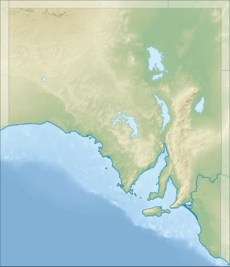Arno Bay, South Australia facts for kids
Quick facts for kids Arno BaySouth Australia |
|||||||||||||||
|---|---|---|---|---|---|---|---|---|---|---|---|---|---|---|---|
| Established | 1882 | ||||||||||||||
| Postcode(s) | 5603 | ||||||||||||||
| Elevation | 1 m (3 ft) | ||||||||||||||
| Time zone | ACST (UTC+9:30) | ||||||||||||||
| • Summer (DST) | ACST (UTC+10:30) | ||||||||||||||
| Location | 437 km (272 mi) NW of Adelaide | ||||||||||||||
| LGA(s) | District Council of Cleve | ||||||||||||||
| Region | Eyre Western | ||||||||||||||
| County | Jervois | ||||||||||||||
| State electorate(s) | Flinders | ||||||||||||||
| Federal Division(s) | Grey | ||||||||||||||
|
|||||||||||||||
| Footnotes | Adjoining localities | ||||||||||||||
Arno Bay is a small, pretty town in South Australia. It's on the east coast of the Eyre Peninsula, right by the sea. You can find it on the Lincoln Highway, between Whyalla and Port Lincoln. The town was first called Bligh in 1883. Its current name, Arno Bay, became official in 1940. It's a great spot for holidays, with lots of fun things to do. You can go fishing, surfing, or swimming in the ocean.
Contents
History of Arno Bay
Early Days of the Town
The area where Arno Bay is now was first settled by farmers in 1863. Back then, it was known as 'Salt Creek Cove'. People tried different things here before the town was built. One idea was to start 'The Arno Bay Mine'. But water quickly filled the mine, stopping all work.
The small town was officially started in 1882. It was named 'Bligh' by G. H. Ayliffe, after Captain William Bligh. However, the people living there didn't like the new name. They kept calling it 'Arno Bay'. This continued until the name was officially changed much later.
Growing as a Port
People thought Arno Bay would become an important port. So, a jetty was built in 1880. A port is a place where ships can load and unload goods. Even though it wasn't a huge port, it was still busy. Ships brought in fertilisers for farms. They took out cereal crops grown in the area.
By 1911, the town had grown a lot. It had a school, a post office, a hotel, and a new town hall. Arno Bay kept growing as a port. In 1940, it exported 11,000 tonnes of grain. That same year, the town's name was finally changed to 'Arno Bay'. This name came from a sandhill well nearby. It was not named after the 'Arno River' in Italy, as some people thought.
A New Chapter for Arno Bay
The time of big exports ended suddenly in 1963. Large storage silos were built, and big trucks took over transport. This meant ships were no longer needed to carry goods. This change marked the end of Arno Bay as a busy port.
The town's population slowly went down after that. Today, Arno Bay is mostly known as a tourist town. People come here for fishing and holidays by the sea.
Where is Arno Bay?
Natural Wonders
Arno Bay is located on the eastern side of the Eyre Peninsula. It sits right on the Spencer Gulf. This is a large body of water that stretches north towards Port Augusta. The town itself is on a bay with the same name. This bay has beautiful white, sandy beaches. It also has tall cliffs and mangrove forests.
A special place here is 'Redbanks'. These are amazing red cliffs made of sedimentary rock. The Geological Society of Australia has named Redbanks a geological monument. This means it's a very important natural site.
The Weather
The weather in Arno Bay is similar to Port Lincoln, which is about 118 km south. It has a Mediterranean-like climate. This means summers are hot and dry. Winters are cool and wet. This type of weather is common for most of the Eyre Peninsula.
How Arno Bay Makes Money
Farming and Fishing
Arno Bay still helps the farms around it. But it's not as busy as it was in the mid-1900s. Farmers in the area still grow cereal crops and raise sheep. They also produce smaller amounts of other goods.
Fishing has always been a small part of the town's economy. Recently, aquaculture has become important in the bay. Aquaculture is like farming fish in the water. They raise fish like Yellowtail Kingfish, mulloway, and tuna in large cages. These fish farms cover about 130 hectares in the bay. Fish farming here is still growing. More expansion is expected in the future.
Fun for Tourists
Tourism is now one of the biggest ways Arno Bay makes money. Visitors usually come for the great fishing, water sports, and the relaxed seaside feeling. There's a boat ramp in town for launching boats. It has a floating dock and a newly fixed jetty.
Many popular fish species are caught in the bay. These include whiting, snapper, tommy ruff, garfish, and salmon. You can catch most of these from the town jetty or the beach. If you have a boat, the 'Redbanks' area is known for big Mulloway and Snapper. It also offers amazing views of the tall cliffs. The local fish farms also welcome visitors. You can take tours to see how they raise the fish.
Life in Arno Bay
Places to Visit and Use
For visitors, Arno Bay has a caravan park right on the beach. There's also a hotel, general stores, and a post office. You'll find a playground and a motor garage. However, there isn't a fuel station in town. The all-weather boat ramp and refurbished jetty make it easy for boaters to get out on the water.
Sports and Fun
Arno Bay has many places for sports and clubs. There's a dried-up swamp that is used as a golf course. You can also find a bowling green, an oval, and courts for tennis, netball, and squash. There's a dirt circuit for racing. In summer, you can watch yacht races every Sunday.


